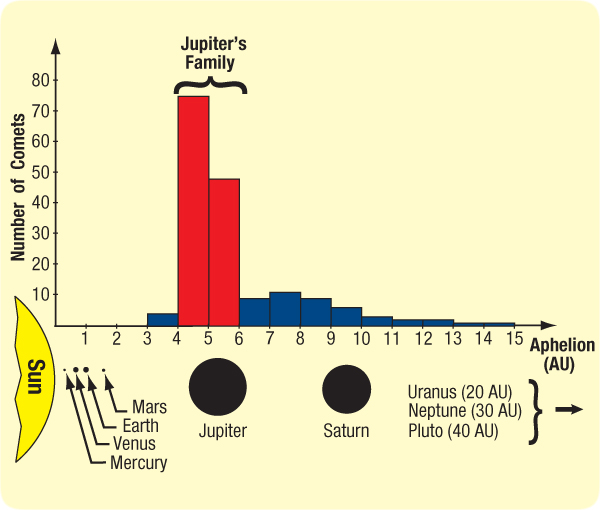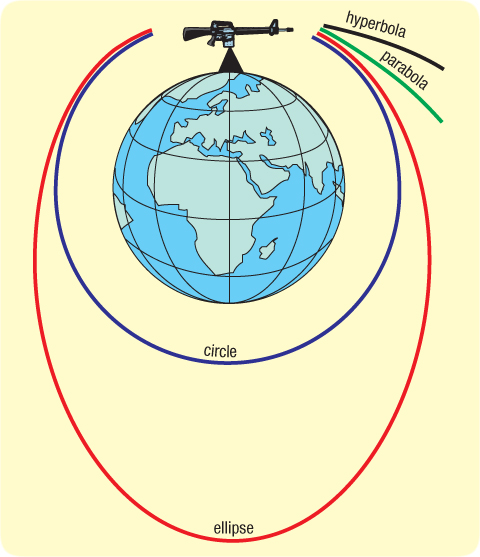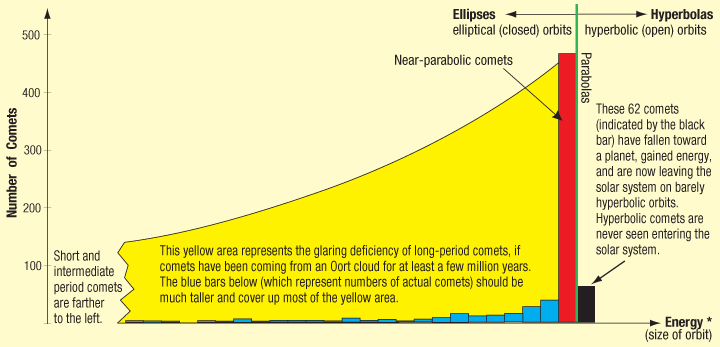Below is the online edition of In the Beginning: Compelling Evidence for Creation and the Flood,
by Dr. Walt Brown. Copyright © Center for Scientific Creation. All rights reserved.
Click here to order the hardbound 8th edition (2008) and other materials.
How Comets Move
Most comets travel on long, oval paths called ellipses that bring them near the Sun and then swing them back out into deep space. [See Figure 175 on page 318.] The point nearest the Sun on an elliptical orbit is called its perihelion. At perihelion, a comet’s speed is greatest. After a comet passes perihelion and begins moving away from the Sun, its velocity steadily decreases until it reaches its farthest point from the Sun—called its aphelion. (This is similar to the way a ball thrown up into the air slows down until it reaches its highest point.) Then, the comet begins falling back toward the Sun, gaining speed until it again reaches perihelion.

Figure 171: What Is Jupiter’s Family? About 60% of all short-period comets have aphelions 4–6 AU from the Sun. (A comet’s aphelion is its farthest point from the Sun.) Because Jupiter travels in a nearly circular orbit that lies near the center of that range (5.2 AU from the Sun), those comets are called Jupiter’s family. (Comets in Jupiter’s family do not travel with Jupiter; those comets and Jupiter have only one orbital characteristic in common—aphelion distance.) Is Saturn, which lies 9.5 AU from the Sun, collecting a family? See the “aphelion scale” directly above each planet.
Why should comets cluster into families defined by aphelions? Why is Jupiter’s family so large? No doubt, Jupiter’s enormous mass has something to do with it. Notice how large Jupiter is compared to other planets and how far each is from the Sun. (In this figure, diameters of the Sun and planets are magnified relative to the aphelion scale.)
Short-Period Comets. Of the 1,139 known comets, that are in elliptical orbits, 737 orbit the Sun in less than 100 years. They are called short-period comets, because the time for each to orbit the Sun once, called the period, is short—less than 100 years.20 Short-period comets usually travel near Earth’s orbital plane, called the ecliptic. Almost all (711) are prograde; that is, they orbit the Sun in the same direction as Earth. Surprisingly, about 60% of all short-period comets have aphelions near some point on Jupiter’s orbit.21 They are called Jupiter’s family. [See Figure 171.]
To understand better what is meant by “Jupiter’s family,” look briefly at Figure 177 on page 321. While comets A, B, and C orbit the Sun, only A and B are in Jupiter’s family, because their farthest points from the Sun, their aphelions, are near Jupiter’s orbit. How Jupiter collected its large family of comets presents major problems for most theories for comet origins, because comets falling toward the Sun from the outer solar system would be traveling too fast as they zip inside Jupiter’s orbit. To slow them down, so they could join Jupiter’s family, would require such great deceleration forces that the comets would have to pass very near planets. But those near passes could easily, produce collisions, tear comets apart, or eject them from the solar system.23
Therefore, comets in Jupiter’s family have a life expectancy of only about 12,000 years.24 This presents three possibilities: (1) Jupiter’s family formed less than about 12,000 years ago, (2) the family is resupplied rapidly by unknown processes, or (3) the family had many more comets prior to about 12,000 years ago—perhaps thousands of times as many. Options (2) and (3) present a terrible collection problem. In other words, too many comets cluster in Jupiter’s family, precisely where few should gather or survive for much longer than about 12,000 years. Why?
Long-Period Comets. Of the 298 comets with periods exceeding 700 years, about half (53%) are prograde, while the rest (47%) are retrograde, orbiting the Sun “backwards”—in a direction opposite that of the Earth. Because no planets have retrograde orbits, we must ask why so many long-period comets are retrograde, while few short-period comets are.
Intermediate-Period Comets. Only 104 comets have orbital periods between 100 and 700 years. So, we have two completely different populations of comets—short-period and long-period—plus a few in between.

Figure 172: An Early Lesson in Conservation of Energy. At the top of his swing, my grandson, Preston, has a minimum of kinetic energy (energy of motion) but a maximum of potential energy (energy of height). As he approaches the bottom of his swing, where he moves the fastest, he gains kinetic energy but loses an equal amount of potential energy. In between, he has some of both.
Eventually, friction converts both forms of energy into heat energy, slowing the swing, and making Preston unhappy. Comets also steadily exchange kinetic and potential energy, but, in the vacuum of space, do so with essentially no frictional loss.
Energy. A comet falling in its orbit toward the Sun exchanges “height above” the Sun for additional speed—just as a ball dropped from a tall building loses elevation but gains speed. Moving away from the Sun, the exchange reverses. A comet’s energy has two parts: potential energy, which increases with the comet’s distance from the Sun, and kinetic energy, which increases with speed. Kinetic energy is converted to potential energy as the comet moves away from the Sun. The beauty of these exchanges is that the sum of the two energies never changes if the comet is influenced only by the Sun; the total energy is conserved (preserved).
However, if a comet orbiting the Sun passes near a planet, energy is transferred between them. What one gains, the other loses; the energy of the comet-planet pair is conserved. A comet falling in the general direction of a planet gains speed, and therefore, energy; moving away from a planet, it loses speed and energy. We say that the planet’s gravity perturbs (or alters) the comet’s orbit. If the comet gains energy, the long axis of its elliptical orbit lengthens. The closer the encounter and more massive the planet, the greater the energy exchange. Jupiter, the largest planet, is 318 times more massive than Earth and causes most large perturbations. In about half of these planetary encounters, comets gain energy, and in half they lose energy.

Figure 173: A Shot Fired Around the World. Imagine standing on a tall mountain rising above the atmosphere. You fire a bullet horizontally. If its speed is just right, and very fast, it will “fall” at the same rate the spherical Earth curves away under the bullet. The bullet would have a circular orbit (blue) around Earth. Simply stated, the bullet would “fall” around the Earth continually. Isaac Newton first suggested this surprising possibility in 1687. It wasn’t until 1957 that the former Soviet Union demonstrated this with a satellite called Sputnik I.
If the bullet were launched more slowly, it would eventually hit the Earth. If the bullet traveled faster, it would be in an oval or elliptical orbit (red).22 With enough additional speed, the orbit would not “loop around” and close on itself. It would be an “open” orbit; the bullet would never return. The green orbit, called a parabolic orbit, is the boundary between open and closed orbits. With any greater launch velocity, the bullet would travel in a hyperbolic orbit; with any less, it would be in an elliptical orbit. These orbits will be discussed in more detail later. Understanding them will help us discover how comets came to be.
If a comet gains enough energy (and therefore speed), it will escape the solar system. Although the Sun’s gravity pulls on the comet as it moves away from the Sun, that pull may decrease so fast with distance that the comet escapes forever. The resulting orbit is not an ellipse (a closed orbit), but a hyperbola (an open orbit). [See Figure 173.] The precise dividing line between ellipses and hyperbolas is an orbit called a parabola. Most long-period comets travel on long, narrow ellipses that are almost parabolas. They are called near-parabolic comets. If they had slightly more velocity, they would permanently escape the solar system on hyperbolic orbits.
Separate Populations. Few comets with short periods will ever change into near-parabolic comets, because the large boost in energy needed is apt to “throw” a comet across the parabola boundary, expelling it permanently from the solar system. The energy boost would have to “snuggle” a comet up next to the parabola boundary without crossing it.25 Also, few long-period comets will become short-period comets, because comets risk getting killed with each near pass of a planet or trip around the Sun. This would be especially true if such dangerous activity went on for millions of years in the “heavy traffic” of the inner solar system.
While all planets travel near Earth’s orbital plane (the ecliptic), long-period and intermediate-period comets have orbital planes inclined at all angles. However, short-period comets usually travel near the ecliptic. Comet inclinations change only slightly with most planet encounters.26 Because few short-period comets can become long-period comets, and vice versa, most must have begun in their current category.
